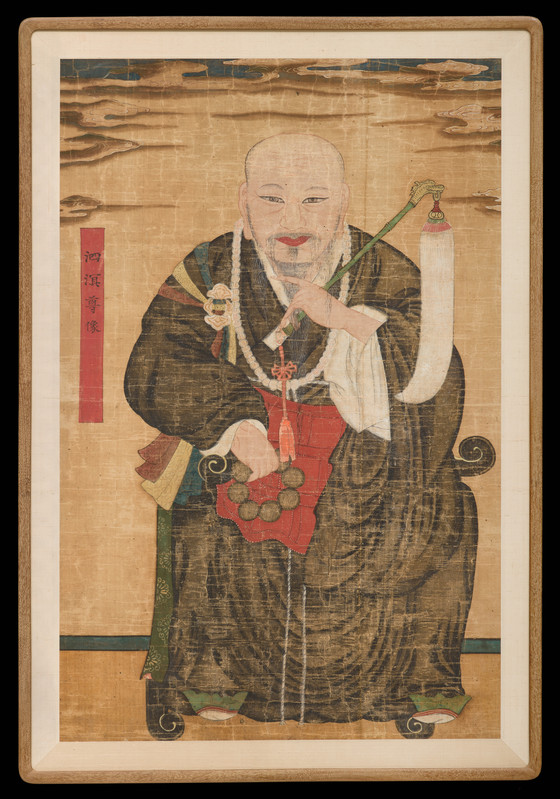After the death of a Buddhist patriarch, his portrait was often painted to pay tribute to him....
After the death of a Buddhist patriarch, his portrait was often painted to pay tribute to him. These portraits, called jinyeong, also symbolized the long history of succession within the sect, thus strengthening the legitimacy and authority among followers. Often, the portraits themselves became subjects of worship. Many temples housed portraits of the first patriarch of the different schools of Buddhism, well-known monks familiar with the doctrinal studies of Buddhism, and monks who benefited the country.
According to the inscription, this is a portrait of the Great Monk Sa’myeong, who was renowned for raising and leading an army of warrior monks to fight the invading Japanese during the Imjin War of 1592. There are also portraits of Sa’myeong at Dongwha Temple, Dongguk University Museum, the small temple of Baekheung’am at Eunhae Temple, and at the small temple of Hongjae’am within Hae’in Temple. In all of these paintings, Sa’myeong is depicted as a stout man with a long beard and eyes that turn upward. Except for the treatment of the beard, which here is relatively short, the LACMA painting of Sa’myeong is similar to the other portraits.
Sa’myeong is shown sitting on a chair, facing forward. He holds a bulja (an implement used to bush away insects) of long white hair in his left hand and Buddhist prayer beads in his right hand (det. 1). The pose in this painting is unusual for the genre. In most portraits of patriarchs, artists depicted them turned slightly to the left or right. When they are shown directly facing the viewer, the patriarchs are usually seated on the floor rather than a chair. In the portrait at Baekheung’am, the artist also portrayed the patriarch on a chair facing forward; however, in this case, Sa’myeong is also shown in a full lotus position (fig. 1).
Sa’myeong’s face in this portrait is painted with ocher pigment (det. 2). The monk’s surplice was first painted with thin ink; then thick ink was applied for the contour and creases. The formalized creases of the robe, the simplified treatment of the patriarch’s wrinkles, and the small size of his hands in relation to his stout frame indicate that this painting was probably created at the end of the nineteenth century.
It is not clear when this genre was first introduced, but literature indicates that portraits of the Buddhist patriarchs Wonhyo, Doyi, and Beomil existed by the Unified Silla period and that more were actively produced during the Goryeo period. Unfortunately, no portraits from those periods remain. Most of the portraits found today were created in the late Joseon period, after the eighteenth century.
In general, the composition of the portraits followed a standard formula. The patriarchs are typically depicted wearing a Buddhist surplice and holding a brush and prayer beads. They sit either on a chair or on the floor with legs crossed – that is, in the full lotus position – with the floor mat giving the effect of a divided background. Initially, the chair-sitting pose was more traditional; portraits showing patriarchs sitting on the floor were mostly created at the end of the eighteenth century. The patriarch’s name was written either on the top right or top left of the painting; often, words of praise were included as well. It was in the facial features that the artists focused on specific details to portray the uniqueness of individuals. This is especially evident in eighteenth- and nineteenth-century portraits. Unfortunately, the portraits of patriarchs from the Unified Silla, Goryeo, and early Joseon periods were damaged over time. Many were repeatedly repainted and retouched, altering the original image.
Bibliography
Chung, WooThak. “Buddhist Patriarchs in the Late Joseon Dynasty [Joseon hugi bulgyo jinyong go].” In Figures Who Follow the Way of Buddhist Enlightenment [Ggaedaleum ui gileul gan eolguldeul]. North Gyeongsang province: Jikji Temple Museum, 2000.
Additional References
Miguk Pakmulgwan Sojang Hanguk Munwhajae (The Korean Relics in the United States). Seoul: Hangukkukjae Munhwa Hyo*phwoi (International Cultural Society of Korea), 1989, 200 See other artworks in this book
More...



